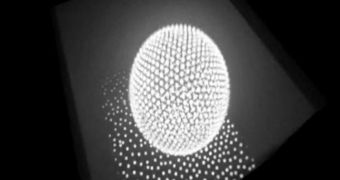Researchers at the Syracuse University (SU) reveal in a new paper that single-layer crystals are capable of healing themselves when an extra particle is inserted into their lattices, provided that the layer itself is curved.
In order to demonstrate this process, the team only had to insert an extra particle into the lattice, and then stand back to watch what happened. Crystal self-healing does not work on flat layers, the research group explains.
Details of the new research effort appear in a paper published in the latest issue of the top scientific journal Nature Materials. Interestingly, the effect was predicted more than 6 years ago, in theory, but was never actually tested before.
SU College of Arts and Sciences professor of physics Mark Bowick was part of the team that made the proposal, alongside colleagues David Nelson, Homin Shin and Alex Travesset. Both studies were supported by the US National Science Foundation (NSF).
Bowick was recently able to set up the experiment by working together with New York University (NYU) Center for Soft Matter Research professor of physics, Paul Chaikin, and NYU PhD student, William T.M. Irvine.
The research group drew inspiration for their studies from mayonnaise, of all things. “Mayonnaise is made from a mixture of olive oil and vinegar, which is essentially water,” Bowick explains.
“You have to beat the ingredients for a long time to disperse tiny droplets of the vinegar in the oil to make an emulsion. In ranch dressing, the surfactant used is ground-up mustard seed particles, which arrange themselves at the interface between the water and the oil,” he adds.
The water-oil mixture (plus the mustard) in mayonnaise was replicating using glycerol droplets (replacing water), a base of oil, and the mustard was emulated using microscopic acrylic glass particles.
“The study of crystals on curved surfaces is interesting and important for systems that range from geodesic domes to viruses to buckyballs,” Chaikin explains.
“The defect structure and the 'healing' of defects are particularly important in the conductivity, heat and mechanical properties of carbon nanotubes, graphene and similar materials,” he concludes.

 14 DAY TRIAL //
14 DAY TRIAL //